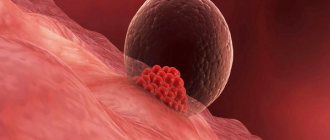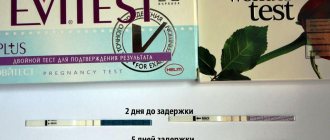The menstrual cycle begins on the first day of menstruation and usually includes three phases: follicular, ovulatory and luteal.
Follicular phase
begins with bleeding, which lasts on average from 3 to 5 days and ends with the maturation of the dominant follicle.
Ovulation
usually occurs at the end of the follicular phase and lasts for 24 hours, which corresponds to the release of the egg from the ovary. At the same time, the ovulatory period does not have a clear duration and, according to experts, depends more on methods for determining ovulation.
Luteal phase
begins after the end of ovulation and, regardless of the length of the woman’s cycle, lasts for 14 days before the start of menstruation.
It is the duration of the luteal phase that helps calculate the start date of ovulation and the onset of the next menstruation. To calculate the start of the next menstrual cycle, add 14 days to the end date of ovulation.
When a woman actively engages in sexual intercourse and at the same time carefully monitors her own health, it is important for her to know how many days after ovulation her period begins. Thanks to this information, it is possible to determine pregnancy, because the unexpected fertilization of an egg does not delight all future parents.
How many days does your period start after ovulation?
When discussing when menstruation begins after ovulation, it is worth mentioning important factors on which this process depends. When the egg is fertilized and reaches the uterus, it implants into the endometrium. This stage is the final stage in the development of pregnancy. It is possible that the female body will reject a zygote that has not had time to consolidate, as a result of which it will die and be released unnoticed when menstruation begins.
The implementation process lasts 40 hours. After this, the embryo is formed, and the body of the expectant mother begins active preparation for bearing the fetus. At the same time, hormonal levels change, and the immune system and protective function of the body deteriorate.
If fertilization was not successful, your period will begin two weeks after ovulation. Often, ladies are faced with a situation when the duration of menstruation is too long - this signals late ovulation.
How long does it take
Since conception is possible only with a developed egg, those who want to become mothers need to know what period of time they have at their disposal. The female gamete is suitable for the process while it travels through the tube to the uterus. Immediately after the shell opens, it slips into the abdominal cavity, where it remains for a short time. Then the fallopian tube draws it into itself. Advancement to the main female organ lasts from 12 to 24 hours (maybe a little longer, as it is slow). For this period, the egg has enough supply of nutrients to exist and maintain its properties. If an active sperm meets her and connects, conception is guaranteed.
Damage to the follicle shell itself and the release of the egg takes longer - from 36 to 48 hours. At this stage, fertilization cannot occur. But if full sexual intercourse occurs at this time, pregnancy will most likely result.
Reasons for delay
Knowing how many days after ovulation menstruation comes, women expect it on a specific day. But they don’t think at all about the fact that the menstrual cycle does not begin on the same day every month. A delay of 1 to 3 days is quite normal and you should not worry about it.
The opposite situation is the absence of menstruation for 5 or more days. The cause here is usually considered to be pregnancy, but this is not the only option. This shift can occur as a result of late ovulation, the use of contraception and hormonal medications. All this contributes to a longer delay - about two weeks. No less common causes are inflammation in the pelvic organs.
If delays in menstruation and strange ovulation occur every month, there is reason to think about the state of your health. Ailments that affect the endocrine system lead to this result. In addition, the following diseases are often the causes: diabetes, pituitary gland, problems with the adrenal glands.
Patients who decide to have an abortion may not count on the timely onset of menstruation, since in most such cases they appear only after a month or even more. Moreover, changes in the cycle are quite likely due to a change in climate, a sharp change in lifestyle, active physical activity, and a rapid decrease in body weight.
Obesity also contributes to irregular periods. This is especially true for women over 30 years of age. Their delay may well mean the start of menopause.
Is it possible to calculate ovulation from the last menstrual period?
You can calculate the time of ovulation if your menstrual cycle is fairly regular. It is recommended to first monitor its duration for some time (it is recommended to do this from 3 to 6 months). Only after this can the ovulation period be calculated; this is usually done using the average value.
We know that the luteal phase of the cycle most often lasts 14 days. Subtract this number from your cycle length to find out approximately what day of your cycle you ovulate on. If you want to understand how many days after the end of menstruation the egg is released, then also subtract the duration of your menstruation. Let's look at these calculations using an example.
Table: example of ovulation day calculations
| Cycle duration | On what day of the cycle does ovulation occur (with a 14-day luteal phase) | How many days after menstruation will ovulation occur (with menstruation at 5 days) |
| 21 | 21–14=7 | 7–5=2 |
| 26 | 26–14=12 | 12–5=7 |
| 28 | 28–14=14 | 14–5=9 |
| 30 | 30–14=16 | 16–5=11 |
| 40 | 40–14=26 | 26–5=21 |
Menstruation with early and late ovulation
Late and early ovulation are features that are not so common in women. They influence the duration of the first, follicular phase. With early ovulation it is very short. With late ovulation, the situation is reversed; the first phase is very long. For example, if your cycle usually lasts 28 days, then ovulation will be considered early on day 12 (or earlier), and ovulation will be considered late - after day 17.
A single early or late ovulation will naturally affect the onset of menstruation. With early ovulation, bleeding begins earlier than the woman expects it, and with late ovulation, on the contrary, there is a delay.
But sometimes such phenomena happen all the time. In this case, it is quite difficult to determine both early and late ovulation on your own, especially if you do not particularly monitor your cycle and health.
Some women diagnose this when they cannot conceive a child for a long time, even if all sexual intercourse occurs on the “correct” days, while others simply notice painful sensations and a change in vaginal discharge to thinner ones on certain days (such signs may indicate that that ovulation has occurred).
This feature may occur for a short time (for example, due to stress or moving). In such a situation, after a couple of cycles everything will return to normal.
In any case, if ovulation is early or late, this method of calculating the time of egg release will not work. A pharmacy ovulation test will help you, as well as ultrasound folliculometry, which allows you to observe the ovulation process over time.
If there is early or late ovulation, its timing can be determined using an ovulation test
Causes of brown discharge before menstruation
For women with health problems, it is especially important to know what day after ovulation your period begins, as it is often confused with the brownish discharge that precedes menstruation. In such cases, ladies complain about early periods, because they believe that this happens immediately after ovulation. But in fact, this opinion is wrong. During menstruation, the uterine cavity is cleared of eggs and endometrium. With brown discharge, specific mucus accumulates in it.
The causes of this pathology are:
- problems with hormonal levels;
- too much physical activity;
- increased psycho-emotional pressure;
- change in climatic conditions.
Additional reasons for early menstruation
When answering the question about at what ovulation period menstruation begins, you need to pay attention to short cycles that can occur in every woman once or twice a year. The reason for this phenomenon is the lack of ovulation. There is no need to worry about this, because the ovary also needs rest. You can only start to panic if anovulatory cycles occur constantly. The activity of the ovaries decreases without warning, so if such a problem is detected, you should quickly consult a doctor.
The following ailments affect the lack of cell ripening:
- sclerotic lesions of the ovaries;
- long-term use of oral contraceptives.;
- diabetes.
Calculation of menstruation
It is quite possible to independently calculate the date of your period based on ovulation data. This can be done at home and without the help of a doctor. Here you will need to know the exact day of ovulation. On average, progesterone works for two weeks. Given this indicator, it is not difficult to determine the start of the next cycle. To do this, you only need to add 14 days to the ovulation date. Then you need to add one more day to the resulting number - this will be the beginning of your period.
But you should not rely completely on this scheme. The thing is that ovulation can shift without making itself felt. In such a situation, calculations will not give the correct result and the exact woman will have to be determined together with the doctor and the ultrasound procedure.
How to count ovulation after menstruation
Only one reason for searching for how to count ovulation after menstruation is important - knowing the day when the probability of conception is maximum. Some people need this in order to subsequently experience all the joy (and, of course, all the difficulties) of motherhood; others, on the contrary, strive to prevent an unwanted pregnancy due to various circumstances.
Experts say that the calendar method is one of the most unreliable. The fact is that ovulation does not occur on a fixed day during each cycle. Moreover, even when the menstrual cycle is constant and equal to 28 days, ovulation can occur on the 14th, 11th, or 16th day. This means that the time period when the egg has left the follicle and is capable of fertilization is quite long, and its duration may differ from cycle to cycle.
My menstrual cycle is 22 days. How to calculate ovulation? Ella, 24 years old
Ella, with this menstrual cycle, ovulation can occur literally 2-3 days after your period. Or maybe later. For greater confidence, use the basal temperature measurement method or purchase a test.
It’s another matter if you need to know the day of ovulation in order to conceive a child. Everything is simple here: do not miss the slightest opportunity for sexual intercourse during the calculated period, and if there are no other problems with the ability to conceive, pregnancy is inevitable, like New Year. But how to count ovulation after menstruation?
Is it possible to ovulate just before your period? Elizaveta, 30 years old
No, Elizabeth, that is impossible. After ovulation, several days pass until the lining of the uterus is ready to receive a fertilized egg. After this, it takes a few more days for the hormonal levels to “reconfigure” and begin to act. And a little more time is needed for the processes in the endometrium to lead to its stratification and separation of its functional layer from the basal one.
The essence of the calendar method
The calendar method of determining days favorable for conception is the simplest and least reliable way. To do this, you first need to keep a calendar of menstruation for at least six months, noting their first day. Then, having data on the duration of the cycle, it is already possible to predict the onset of the next menstruation and subtract 14 from the expected date obtained. This figure is quite stable, regardless of the duration of the cycle. For example, with a 29-day monthly cycle, ovulation will occur on the 15th day (29-14=15).
However, when calculating days for conception, it is better to use this method in a more detailed form:
- for calculations, take into account the longest and shortest cycles (with an irregular cycle);
- subtract 10 from the duration of the long one;
- from short duration - 19;
- the resulting two digits are the period of favorable days.
For example, if the shortest cycle is 26 days, and the longest is 30, then days 7 to 20 will be favorable for conception.
Remember that it is not advisable to use this method for contraception, since a regular cycle, which is usually stable, can suddenly lengthen or shorten under the influence of various factors, and this is impossible to predict.
When does ovulation begin after menstruation and how long does it last? Maria, 22 years old
Maria, the day of ovulation is an individual thing and not always constant. If for one woman this happens on the 14th day, for another it can happen on the 8th day from the first day of menstruation, for a third - on the 17th. Moreover, for the same woman, ovulation can occur on different days under the influence of external and internal factors (illness, stress, strain, hormonal imbalances, etc.) Regarding its duration: this is a moment. One moment the egg is still in the ovary, and the next moment it is already outside it and is ready for fertilization within 24 hours. If you are interested in its ability to fertilize, then this is a day or two.
Basal temperature measurement
The second method is measuring basal temperature. This indicator is determined by placing a regular thermometer in the rectum in the morning immediately after waking up. It is important to take your temperature before you begin any daily activity, even before getting out of bed. It’s better to put the thermometer on the bedside table in the evening so as not to get up.
Measurements should be taken at the same time every day without skipping for several months (preferably six months). You can place a thermometer in both the mouth and vagina, but these methods are somewhat less accurate. In any case, it is necessary to measure only one way all the time, since the temperature in the rectum, vagina and mouth differs by several tenths of a degree.
If your period started on the 15th, what date will you ovulate? Oksana, 27 years old
Oksana, the information you provided is not enough to answer. At a minimum, you also need to know the duration of the menstrual cycle. Without this data it is impossible to answer your question.
The value of basal temperature is influenced by both hormones released in the ovaries and other factors. Therefore, during the measurement period, you need to give up alcoholic beverages, avoid stress, and prolonged unusual physical activity. If everything is done correctly, the measurement data will be something like this:
- in the follicular phase of the menstrual cycle, the temperature of a healthy woman is always below 37ºC;
- immediately before ovulation there is a slight decrease of 0.1-0.2ºС;
- ovulation itself provokes a jump of 0.3-1ºС;
- During the entire luteal phase of the cycle, the temperature almost very rarely drops below 37ºC.
The method of measuring basal temperature is quite accurate. Its disadvantage is that it only shows the moment of ovulation itself. If it is used to determine favorable days for conception, then you will have to hurry - the egg dies within 24 hours from the moment of ovulation. That is, you only have a day of maximum probability of conception. However, you can try to combine the calendar method with the temperature method to increase the chances of a successful outcome
When does ovulation occur after menstruation with a 30-day cycle. Alena, 23 years old
Hello, Alena. In a healthy woman, ovulation usually occurs within two weeks, counting from the first day of menstruation. With a 30-day cycle, it can be between 9 and 21 days, but the most likely days are from 12 to 16.
About some secrets
Problems with menstruation and difficulties in determining their onset after ovulation often arise due to taking pills, diets, physical activity, as well as liposuction - ladies do all this in order to lose excess weight. Since their desire to say goodbye to the hated kilograms is very strong, they put a strong strain on the body and dramatically change their lifestyle. Because of this, problems begin in the functioning of internal organs and systems.
Losing weight really takes a lot of time, especially if your initial body weight is significantly higher than normal. But you should not resort to drastic measures to speed up this process. It is enough just to limit the consumption of sweets and starchy foods, switch to healthy foods and gradually introduce physical activity into your life. Then it will be easier for the body to readjust itself, and you can safely forget about problems with ovulation and menstruation.
The second half of the menstrual cycle is the time from ovulation to the onset of the next menstruation. In medicine, this period is called the luteal phase or the corpus luteum phase. Usually it has a fairly stable duration, fluctuations and shifts are rare.
- Menstruation
- Ovulation
- High probability of conception
Ovulation occurs 14 days before the start of the menstrual cycle (with a 28-day cycle - on the 14th day). Deviation from the average value occurs frequently, so the calculation is approximate.
Features of the luteal phase
The female cycle follows a certain pattern, in which one stage replaces another. The first half of the cycle is called follicular , because at this time the follicle with the egg inside matures, then ovulation occurs , which divides the cycle into two phases.
After the release of the egg, a corpus luteum is formed on the surface of the gonad - a temporary gland. It is located where the follicle was and consists of the residual part of its membranes.
The corpus luteum produces progesterone, and it is under the influence of this female sex hormone that the second half of the cycle occurs.
Progesterone carefully creates optimal conditions in the female body for the development of a possible pregnancy. Even if there was no conception, the corpus luteum still functions properly if ovulation has occurred. When conception is complete, after about a week the embryo is implanted in the uterine cavity, the chorionic villi begin to produce the hormone hCG, under the influence of which the corpus luteum lives and thrives until approximately the end of the first trimester. Progesterone remains high and menstruation does not occur.
If a woman is not pregnant, then the gland is active for 10-12 days, and then regresses without the support of hCG, decreases, and stops producing progesterone. The level of estrogen rises again and the endometrium, carefully increased by the influence of progesterone, begins to be rejected as biologically unnecessary. This is menstruation.
How does the female gamete develop in the cycle?
Since adolescence, girls have many follicles formed in their gonads every month, among which one dominates. This is controlled by the hormone FSH. Normally, in all cycles the process takes place in only one of the paired organs. On its surface there is a vesicle, under the shell of which the egg lives.
A further description of what is happening will help to understand when ovulation occurs, before or after menstruation. The follicle grows, forcing the surface layer of the organ to stretch. One day it breaks through and the egg ends up in the abdominal cavity. This is ovulation. In the area of the opened follicle, a corpus luteum remains, which produces hormones. It prepares the conditions for the life of the fertilized egg if the female cell manages to connect with the male one. Without this, fertilization does not occur. And if so, the egg degrades, the corpus luteum disappears. The uterine mucosa also fades away, preparing for rejection. The volume of hormones gradually decreases. It all ends with menstruation, during which the endometrium is renewed. And hormones prepare the reproductive system for separation from the general mass and the development of the next follicle.
How long does it last?
If the first half of the cycle can be longer or shorter in women, since it is very dependent on the concentration and ratio of numerous hormones important for ovulation (FSH, LH, estradiol, testosterone, prolactin), then the second half of the cycle after ovulation is more stable. It usually lasts 14 days. An error of 1 day in one direction or another is considered acceptable.
It is on this property that the calendar calculation of ovulation is based - 14 is subtracted from the duration of a particular woman’s cycle - the most constant value in the female cycle.
This is the answer to the question, how many days does your period come after ovulation - after 14 days. If there is a delay in menstruation, there is always one of the reasons:
- ovulation occurred later (that is, the first phase lengthened);
- pregnancy has occurred (progesterone does not decrease, and therefore there is no menstruation);
- There was no ovulation, a hormonal imbalance occurred.
Important! The duration of the luteal phase is approximately the same, regardless of age, health status and cycle length in different women. Therefore, for women with an irregular cycle, its duration remains the same as for women with regular menstruation.
Menstruation is not possible immediately after ovulation . If bleeding appears earlier than 14 days after the release of the egg from the follicle, they speak of the onset of intermenstrual bleeding, which can be a symptom of a variety of abnormalities in women’s health - from gynecological inflammatory ailments and sexually transmitted infections to surgical pathologies, neoplasms and tumors.
On what day is ovulation celebrated?
Ovulation after menstruation occurs 10 to 18 days later. This inaccuracy is caused by the variability in cycle times among women. If it lasts 21 days, the egg will be released somewhere on the 10th. With a 30-day cycle, this will happen on the 14th - 15th. In a word, its ripening to the state necessary for conception lasts approximately half of the menstrual period.
But this is if the cycle exists without failures. For those who cannot boast of such an advantage, it is more difficult to calculate the maturation of the egg. After all, the cycle is divided into 2 parts - follicular and luteal. One of them can prolong, the second can shorten. And the period for the release of the female gamete exists just between these stages. The difference in their duration often raises the question: can ovulation occur immediately after menstruation? This is exactly what happens during the “jumping” cycle. But even if it is clear enough, early ovulation cannot be completely denied. After all, it can move due to:
- stress, stress
- fatigue,
- medicines,
- sudden changes in nutrition and climatic conditions.
Ovulation immediately after menstruation with a regular cycle is also likely. The egg develops in only one gonad. But in any of the cycles it is possible that a similar process will accelerate in the remaining ovary. While the first female gamete in terms of time of release will degrade, the other will begin to develop. And by the end of menstruation, it will come out of the shell.
Ovulation immediately after menstruation may occur due to dysfunction of the hypothalamus. This part of the brain controls the production of hormones that stimulate the activity of the pituitary gland and ovaries. If there are too many of them for the luteal part of the cycle, the egg may be formed at the initial stage of the next menstrual period.
Menstrual cycle
Possible disorders and diagnosis
Determining whether the luteal phase is normal is very important for women who cannot conceive a baby, suffer from miscarriage, and also find it difficult to determine the duration of their cycle due to its irregularity. In this case, two types of studies are indicated.
- Ultrasound to determine the fact of ovulation . After menstruation, until the middle of the cycle, the maturation of the follicle and its size are noted; after it, after 3-4 days, the presence of the corpus luteum in the ovary can be determined, which will be the main and indisputable confirmation of the accomplished ovulation.
- Blood tests for hormones.
Signs of ovulation
You can determine when an egg becomes fertile by knowing the length of the menstrual cycle. But some women (about 20%) have very noticeable signs of ovulation after menstruation:
- Pain in the lower abdominal segment. It is expressed in the area of the paired gland in which the follicle has matured. The pain is gripping or aching, normally not intense.
- Small discharge with blood from the genital tract. They are caused by damage to blood vessels when the membrane of the Graafian vesicle ruptures.
- Increased colorless vaginal discharge. This phenomenon is caused by hormones. Nature facilitates the path of the sperm to the female gamete. Cervical mucus becomes thinner.
- Increased libido. This mechanism is aimed at achieving conception. The increase in craving for the opposite sex is especially noticeable at this stage of the cycle at the age of 25 - 35 years.
- The presence of nausea, discomfort in the stomach, dizziness for a short time.
Of all the above manifestations, most women, with due attention, only notice that more clear mucus comes out of the vagina and sexual appetite increases.
Useful tips
A woman for whom it is important to maintain reproductive health cannot somehow significantly influence the course of the phases of the menstrual cycle, because they do not obey her, but she can adhere to simple recommendations that will help normalize the cycle:
- have regular sex life (its irregularity negatively affects hormonal levels and often causes phase shifts);
- do not use hormonal drugs and antidepressants without a doctor’s prescription;
- treat gynecological diseases in a timely manner, visit a doctor for examination and prevention at least once a year, even if there are no complaints;
- monitor the duration of the cycle, keep a women's calendar; if there are irregularities for more than 3 days in two or more cycles in a row, it is important to contact a gynecologist-endocrinologist;
- lead a healthy lifestyle, try to get at least 8 hours of sleep a night, don’t smoke or drink alcohol or psychotropic substances, move more, be active;
- use “fire” hormonal contraception as little as possible;
- monitor your weight and nutrition.










